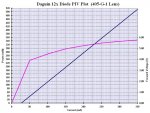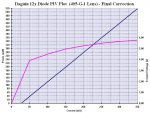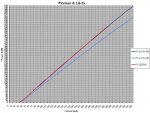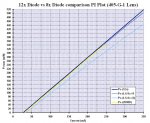.....Where do you see the 50-100mw increase? So far we've seen an 8x at 530mw tops, the 12x is still at 519.
Paying that much more to get 2% more efficiency then the average 8x will probably be worth it when these drives go down to $50
Hmm, i know what Tabish is talking about, but i don't understand what you are trying to say...
He was referring to something i said (
"if 12x's are 'cherry-picked' (= only very high efficiency)
8x diodes, it might be worth paying the $50 more, to make sure you don't get a low efficiency one")...
Take a look at my comparison plot of just the first three 8x diodes i ever tested (soon i'll add 11 to that). You can see that two have a very high efficiency, almost overlapping, and very close to the 12x Dave measured, while one has a quite low efficiency. At the end of the plot, the lower efficiency one produces 60mW less than the two high efficiency ones..
And some 8x's may have an even lower efficiency than the lowest in this plot, while 12x's might only have the high efficiency and very high efficiency ones (IF it should be true, that they are same model as 8x, but "hand-picked" for their efficiency)... So 100mW more is maybe an exaggeration, but even these three display a 60mW difference, and i expect to see more, so he hit the right range.
... there will surely be a new diode (450mw pulsed) in 12x 4 layer drives, a couple years down the road, and there will be several manufacturers come out with those at the same time, because all of them will have the same diode available, unlike this time where the intelligence (selecting good diodes) and mechanical advances have allowed Pioneer to make this jump.
You're too hung up on those vibrations..
I have 6x diodes, which when plotted using the same lens, would PERFECTČY overlap the high efficiency 8x's and the only 12x ever (insuficiently) tested so far..
Would you then say that 8x's are same as 6x's too, and start talkng about vibrations? One of the 6x's i mentioned is in my favorite personal laser. I can put the 405-G-1 lens in, and plot it right now!
I was actually considering doing it before, just to show you that
one overlapping plot doesn't mean shit!
Look, they achieved a 50% higher writing speed. But not with a 50% more powerful diode!
8x's use a 125/250mW diode... The 12x's are supposed to use a 150/300mW diode. Sony is making a 160/320mW diode for 12x's but it's still under developement. Other manufacturers are most likelly already in full production for a while by now with their 300mW Pulsed diodes..
Anyway, they reached a 50% higher writing speed with only a 20% more powerful diode!
How, if they even used the same sled? (Never mind the same sled, they even used it without the beam circularizer!?!) Maybe by getting rid of those vibrations you so love to talk about? Now that would make more sense.
Let's not forget that the same Pioneer says that these speeds are only achievable on "properly configured computers", and that they "can't guarantee 12x speed with all media" (they tested their own media and another major company's). This makes me pretty sure of the fact that they
"barely" achieved these writing speeds, maximizing efficiency of what they already had.
And let's not forget, that this doesn't mean or proove ANYTHING of the kind you are suggesting...
Properly configured computers? Yeah, they need the correct interface.
Special media? Yea, it has to have 12x marked on it! :thinking:
If this was about 10x's, the ones that appeared for a short time in obscure places and then dissapeared, i would sooner believe that the same diode was used..
But it's not..
In the meantime some better testing should be done with 8x and 12x diodes side by side, using the same driver and the same lenses for both diodes, and measuring current, voltage, watts in and out.
Then either contribute and do it (or contribute to the murder fund if we decide to do it to a 12x as well), or wait until it's done, before you decide you are 100% correct..
Oh, and can you explain the reasoning behind "same driver" to me please? With most people it's the DMM that displays the current flowing through the diode. And DMMs are usually (like always) calibrated and very accurate. So if a DMM shows 300mA from one driver, and another DMM shows 300mA from another driver, i usually believe both.
If i was complaining about anything even remotelly related to this, it would be DMM accuracy. The driver doesn't matter, since the current is set according to the DMM.
I'm much more concerned about people comparing plots made on different LPMs, when i know that some show ~7% too much.
In any case, attached is the plot of three 8x's i was referring to. The two high efficiency ones almost overlap Dave's plot, altho i think i recall his meter shows 2% more than mine... When i combine this with the 12x plot, i'll make a direct comparison, and one where i'll correct the numbers by these 2%..
I do these plots on a special driver i built just for the purpose of testing diodes, and this driver has both a current and a forward voltage display mounted on it's enclosure. And you know why i'm not worried that it's a different driver from the one Dave uses? Beause it's the DPMs that have to be accurate in my case, and DMMs in his. And i checked the calibration of my DPMs against the best DMM i have in my workshop..
Take a look at the plot now, while i go combine it with the 12x one...
P.S. Oh and BTW, i'm NOT saying it's impossible that your hypothesis would be correct. But so far you have not provided any evidence or a good enough reason to believe it withot a doubt..







